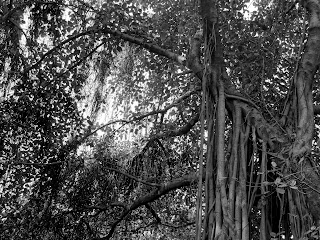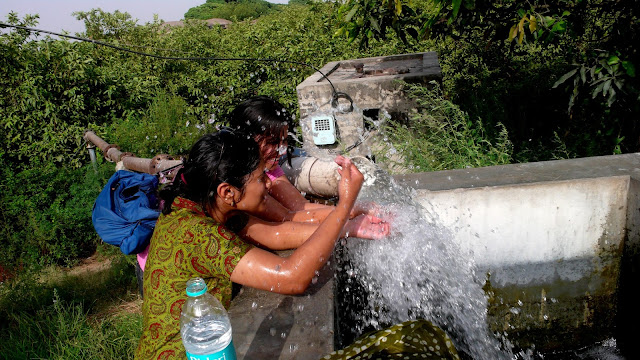Date: 2nd June, 2012,
Saturday
Location: Sarai Lashkari Khan,
Settlement Kot Panech, District: Kapurthala, Punjab
Most of my generation wouldn’t know or care two hoots about Doraha
Sarai, Sarai Lashkari Khan or the GT or any of the Mughal precincts. What we do
care about are our movies, our actors, our celebrities and their lives. When we
were en route the GT, headed to the Sarai Lashkari Khan, I was told that this was
That Fort-like structure which was filmed in Rand de Basanti- the blockbuster hit movie of 2006, which fetched accolades
and critical acclaim for its realism and inspirational value. The scene in the
song Roobaroo, where the four
renegades – Aamir, Sharman, Karan and Kunal all chase an Indian Army jet
fighter flying overhead and jump up in the air attempting to catch it- all
shirtless, waving their shirts in the air through a dense and tall growth of
weeds running across the courtyard of the fort. It was youth in its full glory.
Finding places away from the eyes of the people to be liberated, like free
birds. I still get the same feeling everytime I watch the movie and the song
with the fort in the backdrop. I call it a fort because that’s what we all used
to call it- how most moviegoers- or common man/ men- still call it.
No one knew this is a Sarai. We didn’t know what a Sarai was in the
first place, least of all that it was on the Grand Trunk road and had a name-
Sarai Lashkari Khan. On my way to the sarai I could visualise the whole scene
from the movie over and over again, it was one of my favorites. Second only to the
scene from Dil Chahta Hai where
Aamir, Akshay and Saif are sitting on the parapet of another old fort in Goa
planning to come to that spot every year ritualistically as a mark of undiluted
friendship. And with each turn, my excitement grew higher.
When we reached Sarai Lashkari Khan, I felt a little bubble
inside me go pop, however vane it may sound. I had thought that once RDB was a
blockbuster, probably the authorities might have realised the value of such
picturesque ruins and might have capitalised on it to open up the monument for
the public. I had visualised a-la Bekal Fort – the fort in Kasargode, Kerala
which rose to fame upon the release of Mani Ratnam’s Bombay for featuring in the song “Kannanale... (Kehna hi kya)”. While one had become a well kept
tourist spot, the other was still in ruins.


 |
| Scenes from the song kannale/kehna hee kya from Bombay, shot in Bekal Fort. |
Sarai Lashkari Khan has an interesting history. To quote from
Jaya Basera’s story of Sarai Lashkari Khan : “Information about the sarai in sources
is very little. Lashkar Khan was not a name of a person but a title that had
been awarded to him. The title suggests that the person was a military
commander in Aurangzeb’s army. The sarai is said to have been constructed
sometime between 1669-70 A.D as trading activities were on an all time high in
Kashmir while Aurangzeb was in Shahajhanabad and to accommodate the traders and
travelers to and fro Kashmir new sarai were to be build on the Delhi – Lahore
stretch of the road, Sarai Lashkari Khan having been constructed with that
understanding.”
But my take on the subject is not architectural. It is
social. When we visited the sarai, its courtyard had the same black ‘charred’
soil that many fields en route had. It is an agricultural practice in Punjab(most
of agrarian India) that once the crop has been harvested the last crop is burnt
for the good health of the soil, to rid it of residues, crop wastes, weeds,
insects etc and prolong its fertility before the next crop is sown. Seeing the
same charred spots on the soil meant people had used this sarai for
cultivation. When I asked around I was told Ajay Devgan was to come here to
shoot some scene in which he wanted the sarai’s courtyard to be cultivated with
yellow flower-bearing crop (maybe sarson
I think) and the crop had to be a certain height- about 4 feet or so. They had
prepped the court for that. Once that was done, they burnt the crop when they
heard the word from the State Archaeological Deptt. that a few people from CRCI
were going for a site visit there soon – that meant us.
To these farmers and the villagers these movies were
bringing in revenue. It was much more useful to cultivate crops to the whims of
actors and directors than follow conservation guidelines or help us architects
preserve the structure the way we foresaw it to happen.
But is it necessarily a bad thing? What do we have
against change and adaptation? Okay, agriculture inside a historic structure
can seem horrifying, but these people live in the present, not the past. They
associate this monument to Ajay Devgans and Aamir Khans and the movies that
have been shot here. If this Sarai has a cinematographic value, why can we not
accept it and work around it? Isn’t a structure as important as it is in the
present? I mean what use is a structure if its sits dissociated with society
and dilapidated as well. Aren’t our methods to emphasize its significance all
null and void if a decade after we move out of the place having restored it, it
just falls right back to pieces because of neglect or lack of ownership? Isn’t
dilapidated yet connected to the people a better treatment than restored yet
unwanted? And can we actually just lecture people to stop shooting films here?
I enjoyed watching the scene in Son of Sardar where Sonakshi Sinha drives into the sarai from the
west gateway on a bike. She hits a wheelie in front of Devgan with Sarai
Lashkari Khan in the background. I thoroughly enjoyed it. Even when we were
watching the trailer together Ridhima and Somya were busy spotting the gaping
hole in the Mosque at Lashkari Khan visible for split seconds in the scene. I
mean, come on…heights of conservationism and maybe institutionalization of our
minds to only think as architects before we thinking as common man. Well if
architecture is a service to society, then the thought process should be the
flipside of this- as a common man (a person at the user end) first and then as
an architect.
No one has heard of caravans for centuries now.
Trading caravans are a forgone culture of the past. The world moved one to
better ways of doing trade. Trade is not really carried out on the Grand Trunk
road anymore. And Sarai’s were built to house moving Caravans- they are called
“Caravansarai(s)”. So now if the people have started encroachment because they
serve as better homes than they do now as trading motels then it is the culture
of the present. Culture is dynamic, it is ever evolving. Then why does heritage
and architecture have to be static? How can the people associate themselves to
the Sarai’s if all we keep telling them is “don’t do this here, and don’t do
that here.” If they have forgotten why it stood there in the first place, it is
to us to remind them, to teach them and equip them with knowledge, because
without knowledge of the past preserving the present is impossible.
Movies were once called talkies. I assume it’s probably because they
talk to the people as before them movies might have been mute. I didn't Google it because I want to keep my ignorance intact in this case. And movies have been known
to be a social stimulus among the youth.
They bring the present and the past to the people and put it out there for them
to watch, witness, judge and not just be entertained by. In days when talkies
never existed, we depended on the printed word for making ourselves heard.
Today the movies do it for us. So I think talkies are good, they are Socially Relevant.
Maybe we could use them to convey heritage conservation related issues as well,
in the way that it reaches the masses and makes them a party to the
responsibility of ownership and belongingness to the historicity of their
settlements.











.JPG)
.JPG)

.jpg)



.jpg)










.JPG)
.JPG)

.JPG)






.JPG)
.JPG)

